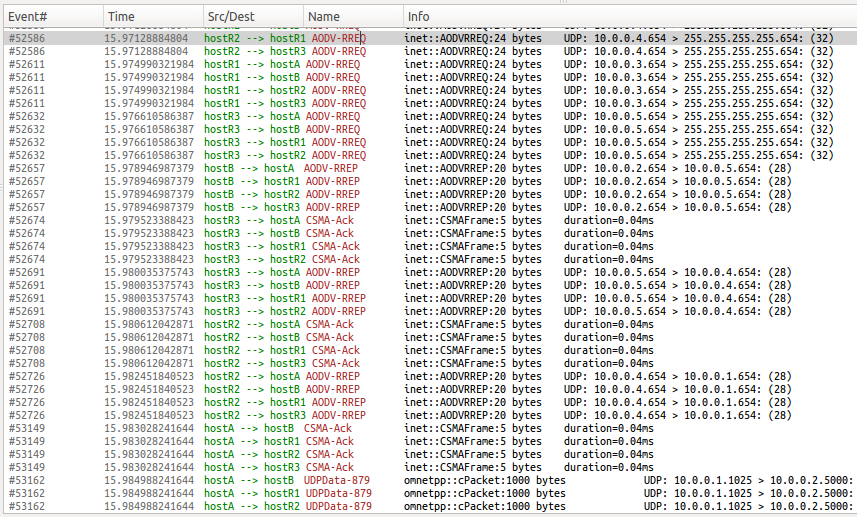Step 10. Configuring ad-hoc routing (AODV)¶
Goals¶
In this step, we configure a routing protocol that adapts to the
changing network topology and will arrange packets to be routed through
R2 and R3 as R1 departs.
We’ll use AODV (ad hoc on-demand distance vector routing). It is a reactive routing protocol, which means its maintenance of the routing tables is driven by demand. This is in contrast to proactive routing protocols which keep routing tables up to date all the time (or at least try to).
The model¶
Let’s configure ad-hoc routing with AODV. As AODV will manage the routing tables, we don’t need the statically added routes anymore. We only need Ipv4NetworkConfigurator to assign the IP addresses and turn all other functions off.
More important, we change the hosts to be instances of AodvRouter.
AodvRouter is like WirelessHost, but with an added
AodvRouting submodule. This change turns each node into an AODV
router.
AODV stands for Ad hoc On-Demand Distance Vector. In AODV, routes are established as they are needed. Once established, a route is maintained as long as it is needed.
In AODV, the network is silent until a connection is needed. At that point, the network node that needs a connection broadcasts a request for connection. Other AODV nodes forward this message and record the node that they heard it from, creating an explosion of temporary routes back to the needy node. When a node receives such a message and already has a route to the desired node, it sends a message backward through a temporary route to the requesting node. The needy node then begins using the route that has the least number of hops through other nodes. Unused entries in the routing tables are recycled after a time.
The message types defined by AODV are Route Request (RREQ), Route Reply (RREP), and Route Error (RERRs). We expect to see these messages at the start of the simulation (when an initial route needs to be established), and later when the topology of the network changes due to the movement of nodes.
The configuration:
[Config Wireless10]
description = Configuring ad-hoc routing (AODV)
extends = Wireless09
*.configurator.addStaticRoutes = false
*.host*.typename = "AodvRouter"
*.hostB.wlan[0].radio.displayCommunicationRange = true
*.visualizer.dataLinkVisualizer.packetFilter = "AODV*"
Results¶
Host R1 moves out of communication range or hosts A and B. The route that was established through R1 is broken. Hosts R2 and R3 are at the right position to relay host A’s packets to host B, and the AODV protocol reconfigures the route to go through R2 and R3. The UDP stream is re-established using these intermediate hosts to relay host A’s packets to host B. This can be seen in the animation below.
AODV detects when a route is no longer able to pass packets. When the link is broken, there are no ACKs arriving at host A, so its AODV submodule triggers the reconfiguration of the route. To detect possible new routes and establish one, there is a burst of AODV transmissions between the hosts, and a new route is established through hosts R2 and R3. This detection and reconfiguration take very little time. After the AODV packet burst, the arrows displaying it fade quickly, and the UDP traffic continues.
The AODV route discovery messages can be seen in the following packet log:
The number of successfully received packets at host B has roughly doubled compared to the previous step. This is because the flow of packets doesn’t stop when host R1 gets out of communication range of host A. Although the AODV protocol adds some overhead, in this simulation, it is not significant, the number of received packets still increases substantially.
Number of packets received by host B: 956
Sources: omnetpp.ini,
WirelessB.ned
